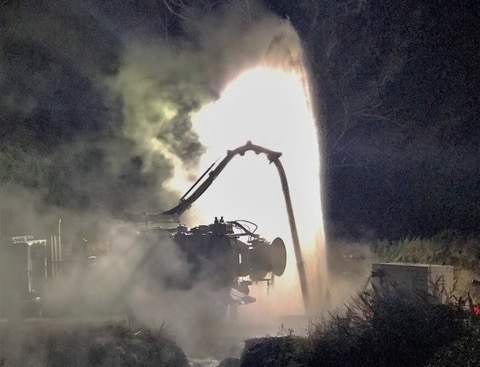
The Laguna Beach City Council on Tuesday unanimously approved the first steps to mitigate damage and assuage a $1.5 million state fine resulting from a 1.7 million gallon sewage spill in November 2019.
During the virtual workshop, City Manager John Pietig pointed out a warning prominently posted in bold print at the bottom of a presentation slide discussing the details of revamping the city’s faulty 4.5-mile sewer pipeline that runs mainly along Coast Highway. The message read: “most disruptive construction in city history.”
“One of the most subtle points of this analysis is the significant disruption that will occur in our town to construct this,” Pietig said. He reminded the council about the storm drain culvert project along Broadway 20 years ago. “The impact on the town was so great there was a revolt and the project was abandoned,” he related. “Can you imagine blocking up Coast Highway for nine months a year for five years?”
The workshop was the first in a 30-day public hearing process to answer the mandates of the $1.5 million fine imposed by the state San Diego Regional Water Quality Board after the massive high-pressure sewage spill in Aliso Canyon. The toxic spew ran into Aliso Creek and then the ocean. The culprit was a ruptured plug on a valve-stem in an underground vault near Ben Brown’s Golf Course, halfway between the Coastal Treatment Plant and the Pacific Ocean.
Councilmembers unanimously agreed to hire firms to study construction ideas to minimize the impact on local traffic, to prepare a study for assessing the physical condition of the city’s North Coast Interceptor (NCI) sewage pipeline and finance a complete revamp of the entire 4.5-mile pipeline. The pipeline runs from a lift station at City Hall along the coast and up Aliso Creek to the Coastal Treatment Plant about a mile uphill in Aliso Canyon.
City staff presented a detailed two-hour staff presentation over Zoom largely based on an analysis by Dudek and Horrocks Engineering firm contracted by the city.
“It seems to me we’ve got a lot of issues here we have to correct,” Mayor Pro Tem Sue Kempf said.
The Council also agreed to allow city staff to pursue funding for the project at a 6 percent household sewer rate increase over five years. The pipeline redo is projected to cost $150 million spread out over a 50-year homeowner sewer rate assessment period.
Councilmembers directed city staff to pursue a low-interest loan for up to $16 million for improvements needed over the next two years. This option would replace the existing NCI pipe along Coast Highway and add a parallel pipeline on Glenneyre from Bluebird Canyon Drive to Ruby Street. The majority of the proposed $9.15 million loan is earmarked to satisfy the state mandate to discontinue piping sewage up Aliso Canyon to the Coastal Treatment Plant.
This project, known as the Intertie, will provide new connecting lines from the city’s NCI pipeline to the South Coast Water District pipeline and will stop at a new lift station on Canyon Drive. The project is intended to relieve pressure on the pipeline and will start at the mouth of Aliso Creek and South Coast Highway. A tentative completion date is scheduled for April 2024.
The public workshop brought out four members of the public to speak and present slides over the internet meeting, most expressing ocean environmental concerns.
Russ Hill of the environmental group Pure Legacy Group asked Laguna Beach to allow his team to perform a pilot study of their more environmental and innovative solutions at no cost.
Even though secondary sewage outfall to the ocean passes legal standards, Hill said that’s not enough. “Legal doesn’t mean healthy,” he said. “ZLD (zero liquid discharge into the ocean) should be the goal.”
The Coastal Treatment Plant in Aliso Canyon now releases from eight to 20 million gallons of treated sewage daily through an outfall pipe that takes the wastewater 1.5 miles offshore. Surrounding cities dump the majority of those millions into the ocean, reported Betty Burnett, general manager of the South Orange County Wastewater Authority.
“With today’s technology and access to federal infrastructure funds, there is no reason to discharge Laguna’s secondary sewage to the ocean and the Marine Protected Areas,” said Mike Beanan, co-founder of the Laguna Bluebelt Coalition.
A resulting polluted water plume circulates up and down the coast and “doesn’t go away,” he said. Upwelling, cold water rising to the top due to ocean currents, brings the settled waste back to the surface, affecting valued marine areas, marine life, and ocean recreation.
The ocean advocates also suggested closing the Coastal Treatment Plant in Aliso Canyon and pumping the sewage to Latham Water Treatment Plant in Dana Point or the Regional Water Treatment Center in Laguna Niguel. Mayor Bob Whalen concurred that this option needs to be studied due to public interest.
“If we could all just wave a magic wand, I’m sure we’d like to get rid of any discharge to the ocean,” Whalen said. “Even if you didn’t get to zero, how do you move more in that direction?”
The answer is to encourage surrounding cities to use more recycled water on landscaping and send less to ocean outfall, Burnett said.




